ITC556 - Database Systems: ER Diagram Modeling for Boat Sales
VerifiedAdded on 2024/05/20
|8
|737
|377
Practical Assignment
AI Summary
This assignment solution focuses on creating an Entity-Relationship (ER) diagram for a boat sales database based on provided business rules. The solution addresses four key tasks, each outlining relationships between different entities such as Manufacture, Type, Model, Warehouse, Customer, and Booking. Each task defines the attributes associated with these entities and specifies the cardinalities of the relationships between them, illustrating how manufacturers produce different types of boats, how boat types relate to models, how models are stored in warehouses, and how customers interact with warehouses through bookings. The ER diagram visually represents these relationships, providing a clear and structured database design for managing boat sales operations. This document is available on Desklib, a platform offering a wide range of study resources including past papers and solved assignments.
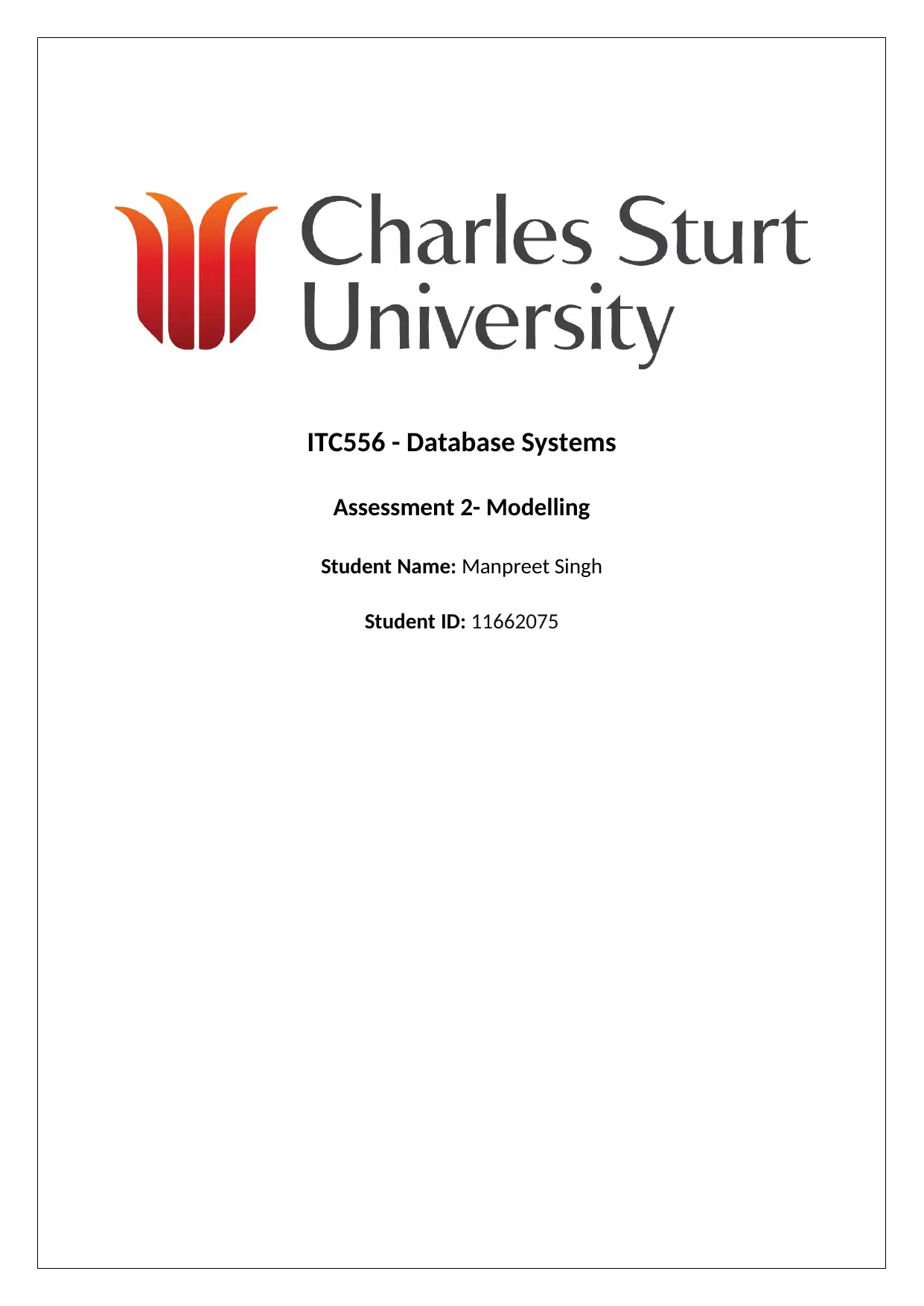
ITC556 - Database Systems
Assessment 2- Modelling
Student Name: Manpreet Singh
Student ID: 11662075
Assessment 2- Modelling
Student Name: Manpreet Singh
Student ID: 11662075
Paraphrase This Document
Need a fresh take? Get an instant paraphrase of this document with our AI Paraphraser
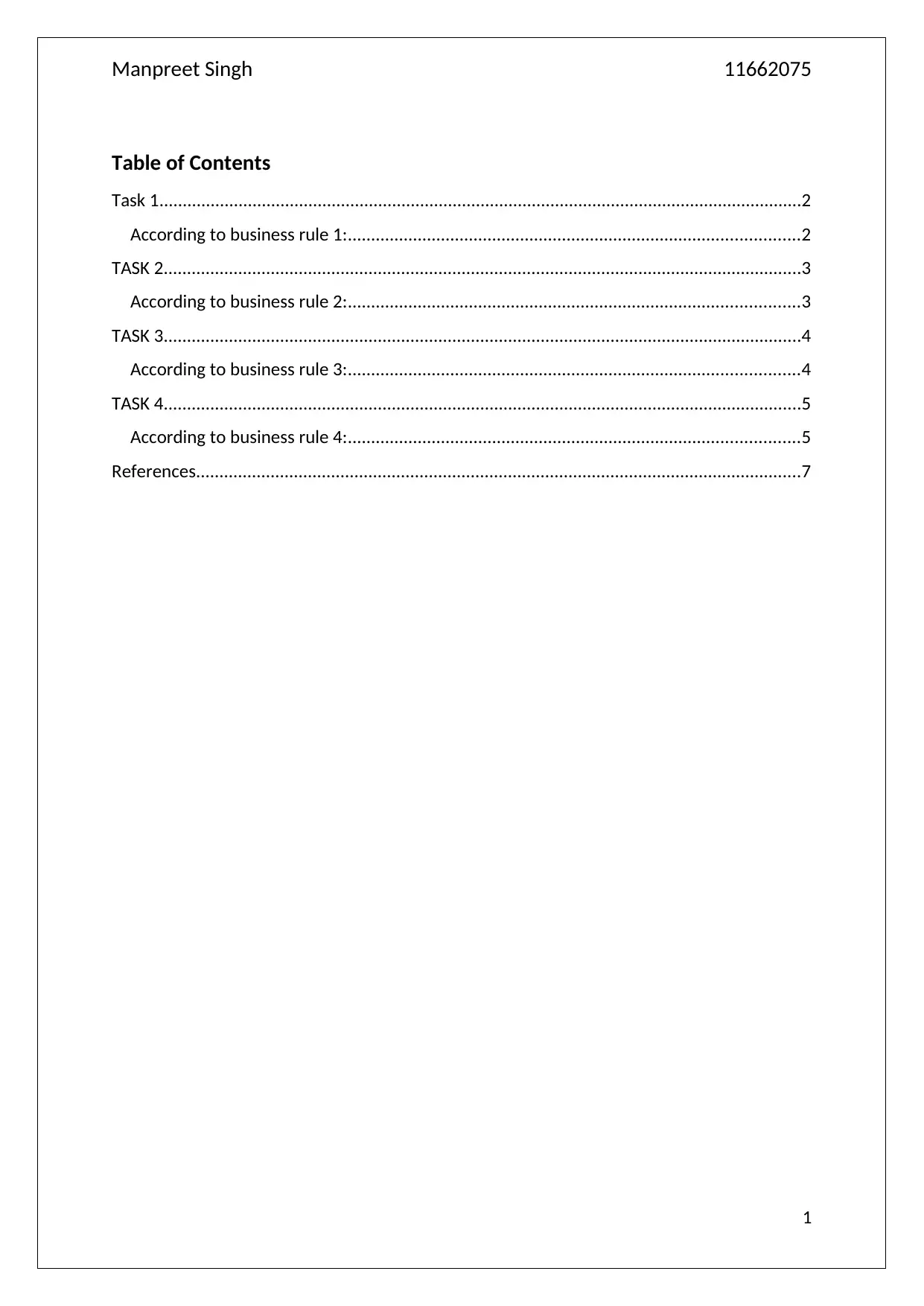
Manpreet Singh 11662075
Table of Contents
Task 1..........................................................................................................................................2
According to business rule 1:.................................................................................................2
TASK 2.........................................................................................................................................3
According to business rule 2:.................................................................................................3
TASK 3.........................................................................................................................................4
According to business rule 3:.................................................................................................4
TASK 4.........................................................................................................................................5
According to business rule 4:.................................................................................................5
References..................................................................................................................................7
1
Table of Contents
Task 1..........................................................................................................................................2
According to business rule 1:.................................................................................................2
TASK 2.........................................................................................................................................3
According to business rule 2:.................................................................................................3
TASK 3.........................................................................................................................................4
According to business rule 3:.................................................................................................4
TASK 4.........................................................................................................................................5
According to business rule 4:.................................................................................................5
References..................................................................................................................................7
1
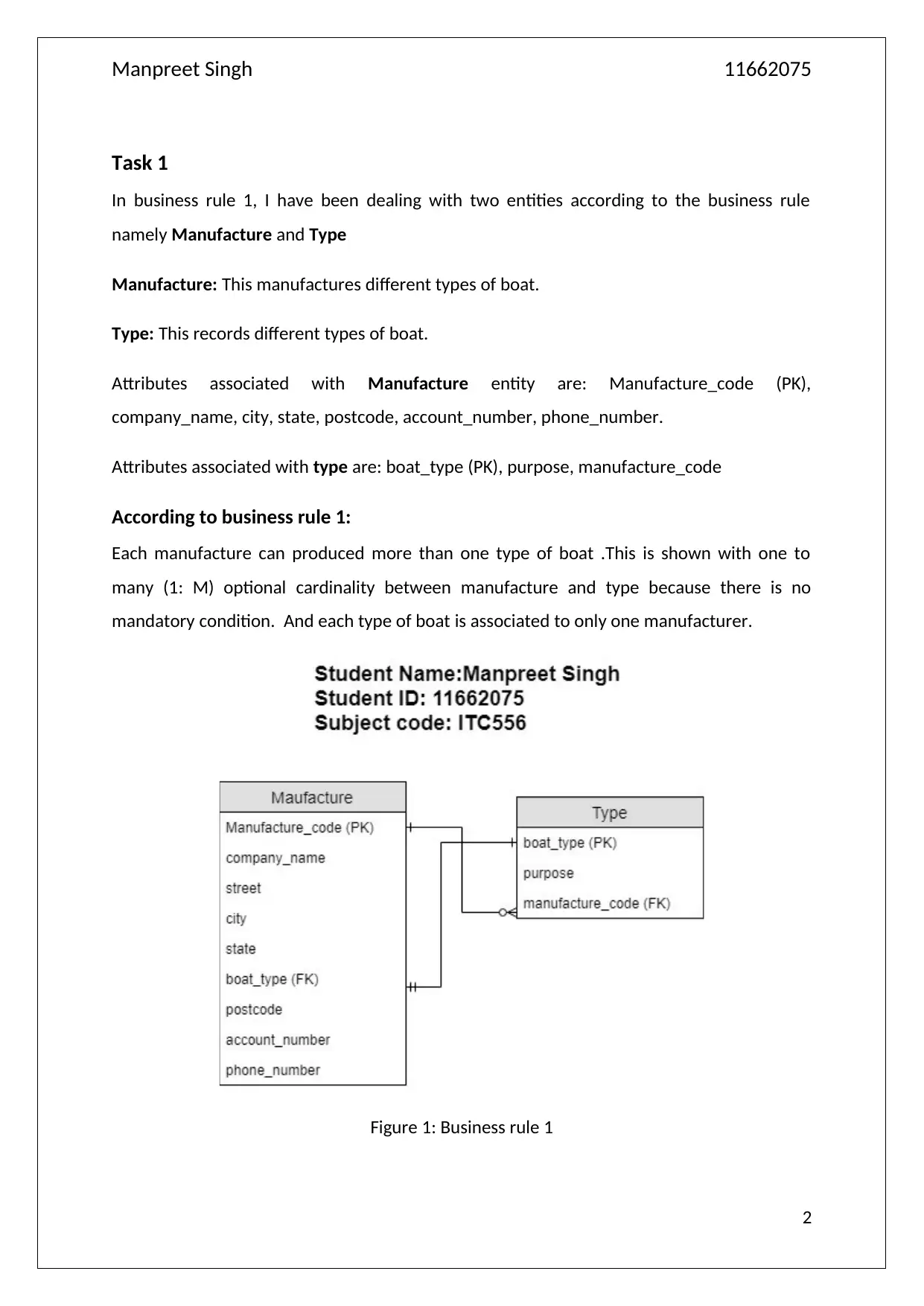
Manpreet Singh 11662075
Task 1
In business rule 1, I have been dealing with two entities according to the business rule
namely Manufacture and Type
Manufacture: This manufactures different types of boat.
Type: This records different types of boat.
Attributes associated with Manufacture entity are: Manufacture_code (PK),
company_name, city, state, postcode, account_number, phone_number.
Attributes associated with type are: boat_type (PK), purpose, manufacture_code
According to business rule 1:
Each manufacture can produced more than one type of boat .This is shown with one to
many (1: M) optional cardinality between manufacture and type because there is no
mandatory condition. And each type of boat is associated to only one manufacturer.
Figure 1: Business rule 1
2
Task 1
In business rule 1, I have been dealing with two entities according to the business rule
namely Manufacture and Type
Manufacture: This manufactures different types of boat.
Type: This records different types of boat.
Attributes associated with Manufacture entity are: Manufacture_code (PK),
company_name, city, state, postcode, account_number, phone_number.
Attributes associated with type are: boat_type (PK), purpose, manufacture_code
According to business rule 1:
Each manufacture can produced more than one type of boat .This is shown with one to
many (1: M) optional cardinality between manufacture and type because there is no
mandatory condition. And each type of boat is associated to only one manufacturer.
Figure 1: Business rule 1
2
⊘ This is a preview!⊘
Do you want full access?
Subscribe today to unlock all pages.

Trusted by 1+ million students worldwide
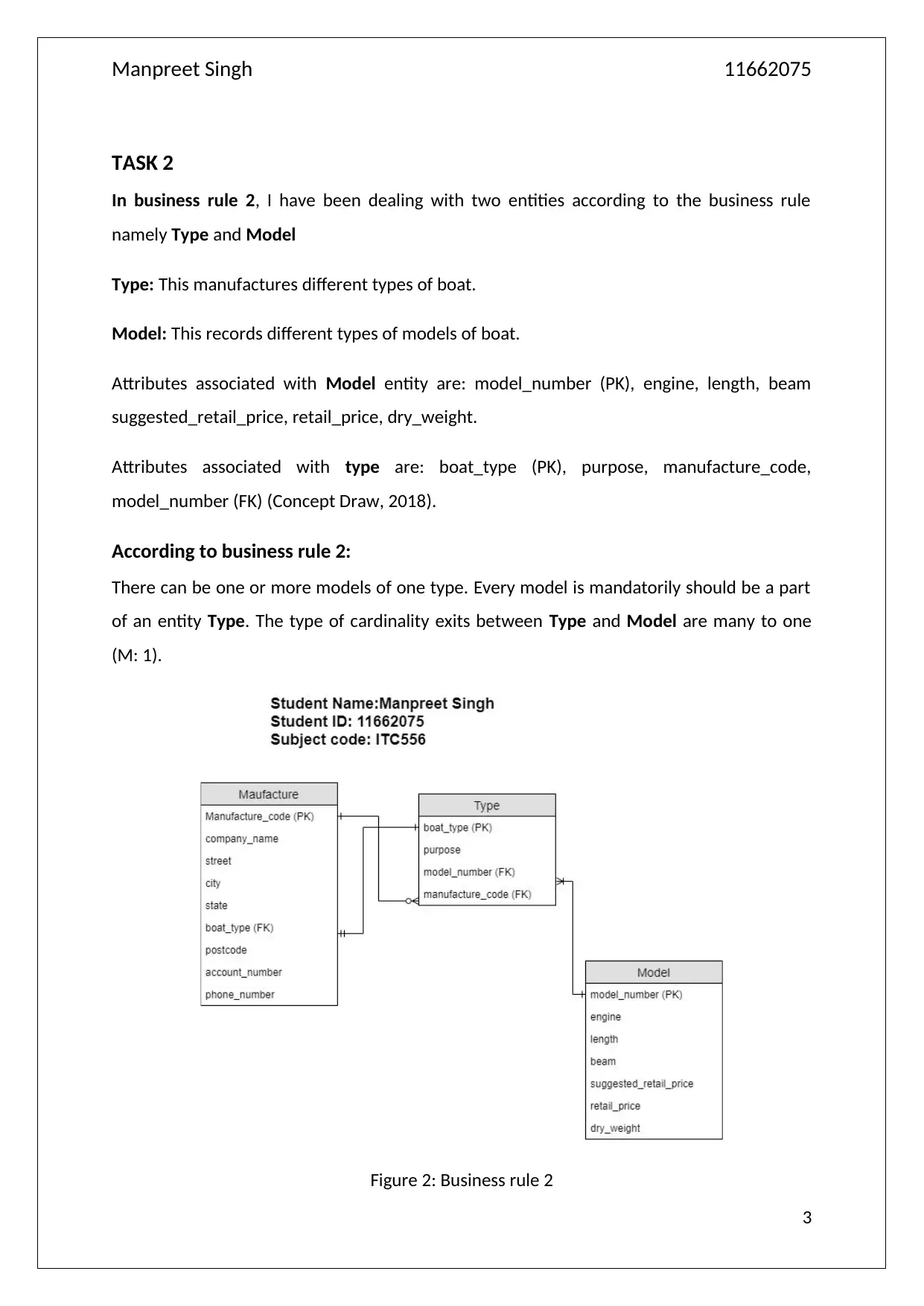
Manpreet Singh 11662075
TASK 2
In business rule 2, I have been dealing with two entities according to the business rule
namely Type and Model
Type: This manufactures different types of boat.
Model: This records different types of models of boat.
Attributes associated with Model entity are: model_number (PK), engine, length, beam
suggested_retail_price, retail_price, dry_weight.
Attributes associated with type are: boat_type (PK), purpose, manufacture_code,
model_number (FK) (Concept Draw, 2018).
According to business rule 2:
There can be one or more models of one type. Every model is mandatorily should be a part
of an entity Type. The type of cardinality exits between Type and Model are many to one
(M: 1).
Figure 2: Business rule 2
3
TASK 2
In business rule 2, I have been dealing with two entities according to the business rule
namely Type and Model
Type: This manufactures different types of boat.
Model: This records different types of models of boat.
Attributes associated with Model entity are: model_number (PK), engine, length, beam
suggested_retail_price, retail_price, dry_weight.
Attributes associated with type are: boat_type (PK), purpose, manufacture_code,
model_number (FK) (Concept Draw, 2018).
According to business rule 2:
There can be one or more models of one type. Every model is mandatorily should be a part
of an entity Type. The type of cardinality exits between Type and Model are many to one
(M: 1).
Figure 2: Business rule 2
3
Paraphrase This Document
Need a fresh take? Get an instant paraphrase of this document with our AI Paraphraser
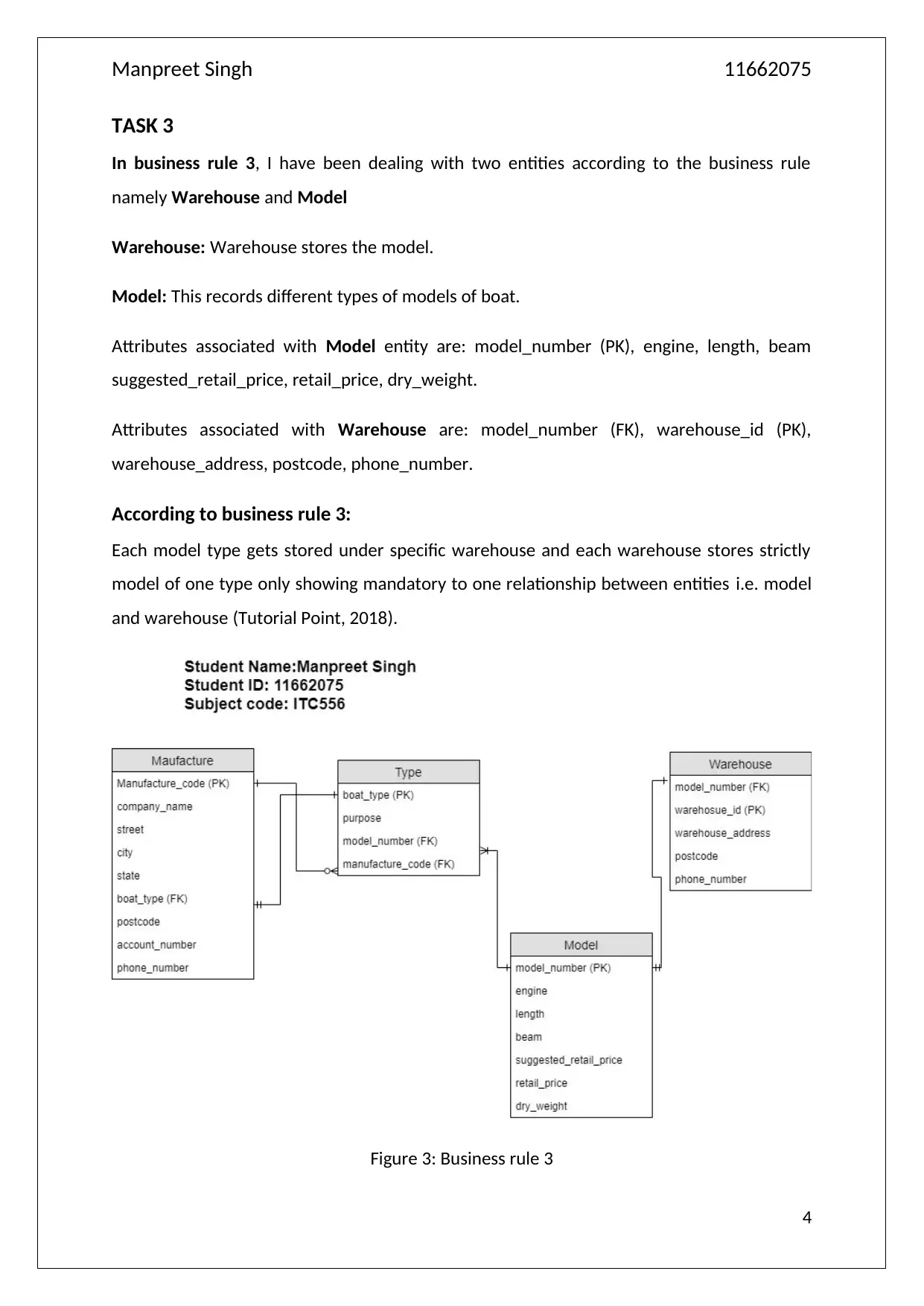
Manpreet Singh 11662075
TASK 3
In business rule 3, I have been dealing with two entities according to the business rule
namely Warehouse and Model
Warehouse: Warehouse stores the model.
Model: This records different types of models of boat.
Attributes associated with Model entity are: model_number (PK), engine, length, beam
suggested_retail_price, retail_price, dry_weight.
Attributes associated with Warehouse are: model_number (FK), warehouse_id (PK),
warehouse_address, postcode, phone_number.
According to business rule 3:
Each model type gets stored under specific warehouse and each warehouse stores strictly
model of one type only showing mandatory to one relationship between entities i.e. model
and warehouse (Tutorial Point, 2018).
Figure 3: Business rule 3
4
TASK 3
In business rule 3, I have been dealing with two entities according to the business rule
namely Warehouse and Model
Warehouse: Warehouse stores the model.
Model: This records different types of models of boat.
Attributes associated with Model entity are: model_number (PK), engine, length, beam
suggested_retail_price, retail_price, dry_weight.
Attributes associated with Warehouse are: model_number (FK), warehouse_id (PK),
warehouse_address, postcode, phone_number.
According to business rule 3:
Each model type gets stored under specific warehouse and each warehouse stores strictly
model of one type only showing mandatory to one relationship between entities i.e. model
and warehouse (Tutorial Point, 2018).
Figure 3: Business rule 3
4
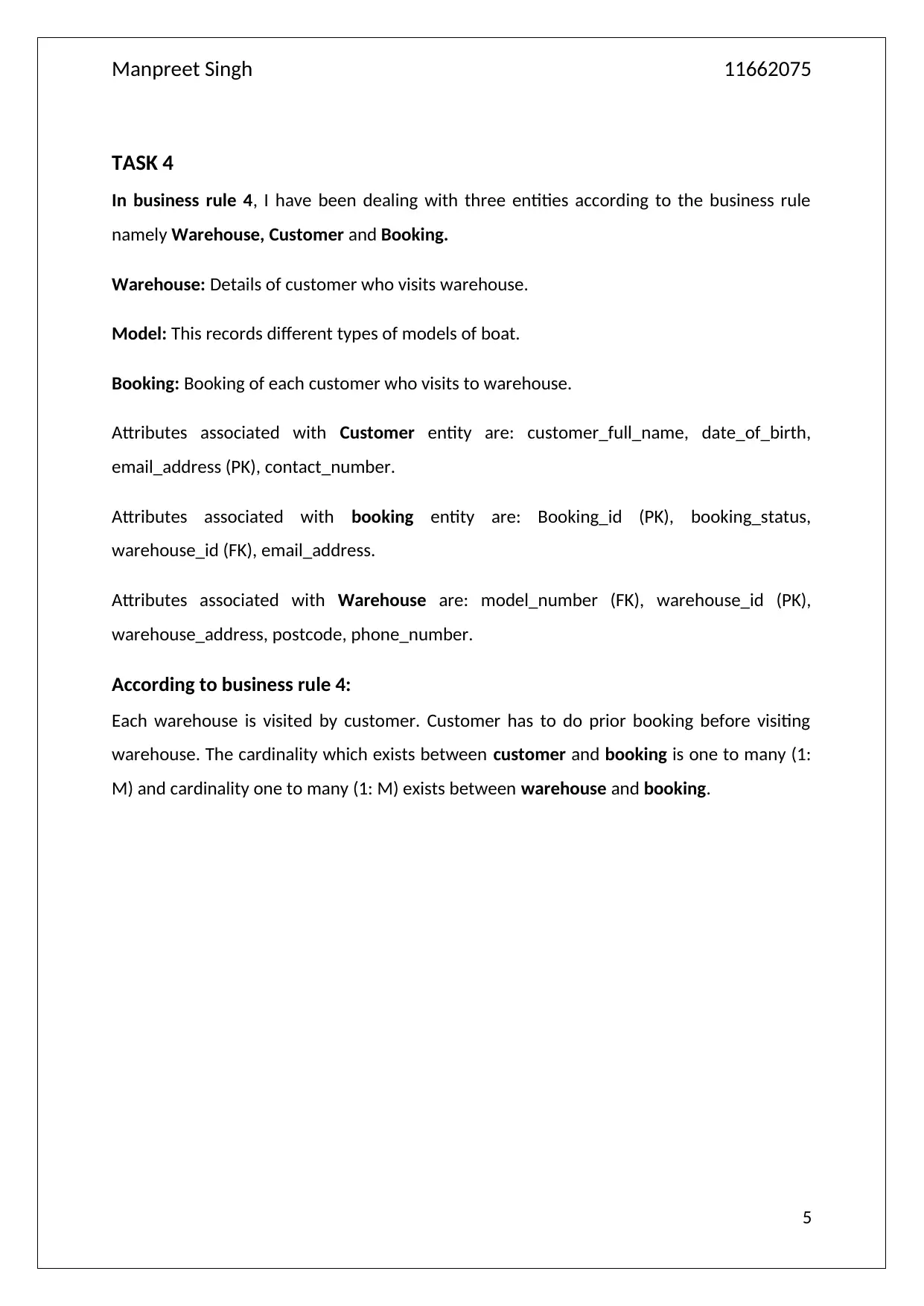
Manpreet Singh 11662075
TASK 4
In business rule 4, I have been dealing with three entities according to the business rule
namely Warehouse, Customer and Booking.
Warehouse: Details of customer who visits warehouse.
Model: This records different types of models of boat.
Booking: Booking of each customer who visits to warehouse.
Attributes associated with Customer entity are: customer_full_name, date_of_birth,
email_address (PK), contact_number.
Attributes associated with booking entity are: Booking_id (PK), booking_status,
warehouse_id (FK), email_address.
Attributes associated with Warehouse are: model_number (FK), warehouse_id (PK),
warehouse_address, postcode, phone_number.
According to business rule 4:
Each warehouse is visited by customer. Customer has to do prior booking before visiting
warehouse. The cardinality which exists between customer and booking is one to many (1:
M) and cardinality one to many (1: M) exists between warehouse and booking.
5
TASK 4
In business rule 4, I have been dealing with three entities according to the business rule
namely Warehouse, Customer and Booking.
Warehouse: Details of customer who visits warehouse.
Model: This records different types of models of boat.
Booking: Booking of each customer who visits to warehouse.
Attributes associated with Customer entity are: customer_full_name, date_of_birth,
email_address (PK), contact_number.
Attributes associated with booking entity are: Booking_id (PK), booking_status,
warehouse_id (FK), email_address.
Attributes associated with Warehouse are: model_number (FK), warehouse_id (PK),
warehouse_address, postcode, phone_number.
According to business rule 4:
Each warehouse is visited by customer. Customer has to do prior booking before visiting
warehouse. The cardinality which exists between customer and booking is one to many (1:
M) and cardinality one to many (1: M) exists between warehouse and booking.
5
⊘ This is a preview!⊘
Do you want full access?
Subscribe today to unlock all pages.

Trusted by 1+ million students worldwide

Manpreet Singh 11662075
Figure 4: Business rule 4
6
Figure 4: Business rule 4
6
Paraphrase This Document
Need a fresh take? Get an instant paraphrase of this document with our AI Paraphraser
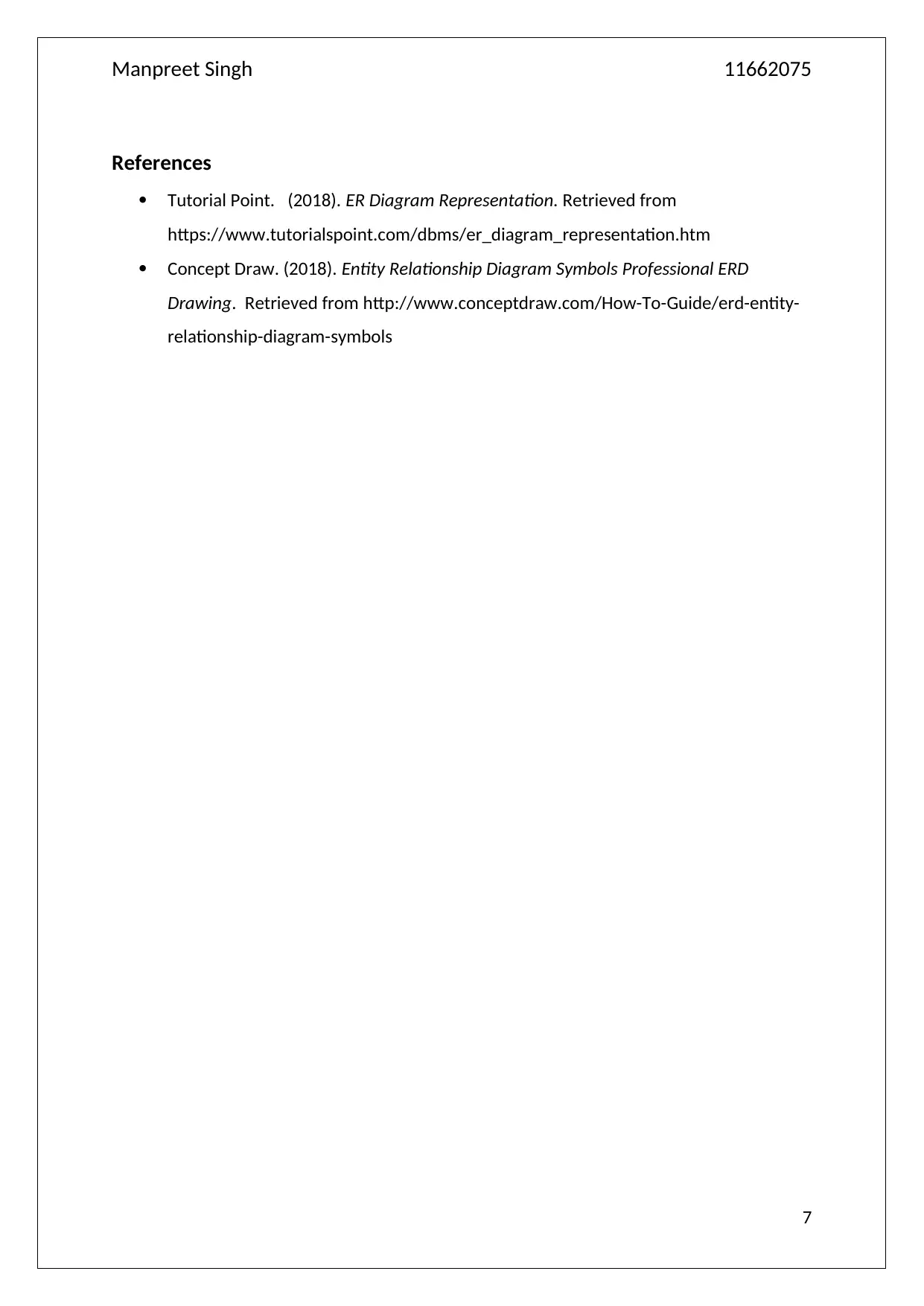
Manpreet Singh 11662075
References
Tutorial Point. (2018). ER Diagram Representation. Retrieved from
https://www.tutorialspoint.com/dbms/er_diagram_representation.htm
Concept Draw. (2018). Entity Relationship Diagram Symbols Professional ERD
Drawing. Retrieved from http://www.conceptdraw.com/How-To-Guide/erd-entity-
relationship-diagram-symbols
7
References
Tutorial Point. (2018). ER Diagram Representation. Retrieved from
https://www.tutorialspoint.com/dbms/er_diagram_representation.htm
Concept Draw. (2018). Entity Relationship Diagram Symbols Professional ERD
Drawing. Retrieved from http://www.conceptdraw.com/How-To-Guide/erd-entity-
relationship-diagram-symbols
7
1 out of 8
Related Documents
Your All-in-One AI-Powered Toolkit for Academic Success.
+13062052269
info@desklib.com
Available 24*7 on WhatsApp / Email
![[object Object]](/_next/static/media/star-bottom.7253800d.svg)
Unlock your academic potential
Copyright © 2020–2025 A2Z Services. All Rights Reserved. Developed and managed by ZUCOL.





